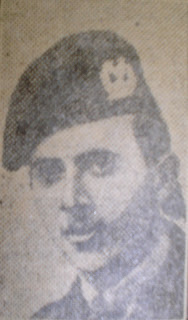22/1653 23rd Battalion Northumberland Fusiliers (4th Tyneside Scottish)
Died of Wounds Ipswich 14th August 1916.
John Robert Wadge was born in Easington County, Durham in May 1881. The 1891 census shows him living in East Hutton, Durham, with his widowed mother. On leaving school he worked as a miner before joining the Regular Army, being attested in Durham.
He enlisted into the Coldstream Guards 25th October 1899, aged 18 years and 5 months, his Regimental being No 3024. Initially posted to the 3rd Battalion, the 1901 census on the 31st March records his residence as Chelsea Barracks. On the 16th January 1902 he was posted to the 2nd Battalion who were in South Africa engaged in the Boer War.
The 2nd Battalion had been sent to Cape Colony at the beginning of the Boer Wars in November 1899. In 1901 their headquarters were situated around Graaf Reinet, but generally the battalion was scattered around the area.
 |
| Coldstream Guards camp Graaf Reinet 1901 - 02 |
John Wadge earned the Queens South Africa Medal with Cape Colony and South Africa 1902 clasps. His terms of engagement were to serve 3 years with the colours, and a further 9 years in the army reserve. He was therefore transferred to the army reserve on expiry of period of army service, 25th October 1902. On 24th October 1911 he was discharged on termination of engagement.
In 1906 he married Jane Ann Hodgson. The 1911 census shows he has been married for 4 years, has two children, and is living with his wife, mother-in-law and her five other children in Gosforth, Newcastle on Tyne. He was active in the local community serving as a local councilor, and on the eve of the First World War resident in Salters Lane.
He enlisted into the Tyneside Scottish in 1914 , and his previous military experience must have contributed to him rising through the ranks to become Regimental Sergeant Major of the 3rd Tyneside Scottish. Graham Stewart / John Sheen’s Tyneside Scottish highlights the contribution made by ex regular soldiers to high level s of discipline and training achieved by the Tyneside Scottish. Initially he was involved in the training of the first three battalions, before being appointed RSM of the fourth battalion.
The Tyneside Scottish deployed to France in January 1916 and initially deployed in the area of Amiens, moving to the Somme in May 1916. Around June 23rd, the 23rd Battalion (4TS), was shelled, and one shell hit the battalion signals dugout. The incident is recorded in Brigadier Ternans’ Story of the Tyneside Scottish “ One day when arriving at Lyles [C0 4 TS] HeadquartersI found a very big shell had crashed through a deep dugout next door to his own, used by the Battalion Signallers, all picked men, six of who were killed instantly.
It was during this incident that RSM Wadge immediately went out under heavy fire and began to dig out the survivors. For this action he was awarded the Military Cross.
His citation from the London Gazette states:
No. 22/1653 S.M. John Robert Wadge, Northumberland Fusiliers. – For conspicuous gallantry during a heavy bombardment. He went out under heavy shellfire and dugout the Battalion Signallers who were buried in a shelter.
On the 1st July 1916, the 4th Battalion were engaged to the North of La Boiselle, their axis being towards Y sap, the 1st Battalion to their left. The Battalion suffered the heaviest casulaties in the Tyneside Scottish Brigade on that day, 668 men killed missing or wounded. The impact on the Tyenside Scottish was such, that they were withdrawn from the line.RSM Wadge died of wounds in Ipswich 14th August 1916.
The esteem to which he was regarded by the local community was reflected in his funeral. He was buried with full military honours, with many local dignitaries attending, 18th August 1916 in St Nicholas Church Yard, Gosforth.
 |
| Evening Chronicle 18th August 1916 |
 |
| RSM JR Wadge MC Illustrated Chronicle |
JR Wadge MC
Gosforth St Nicholas Churchyard
















